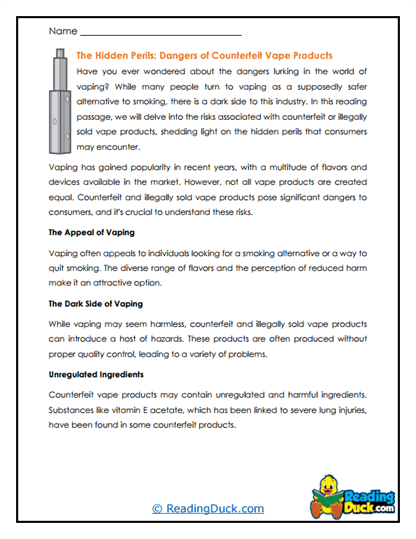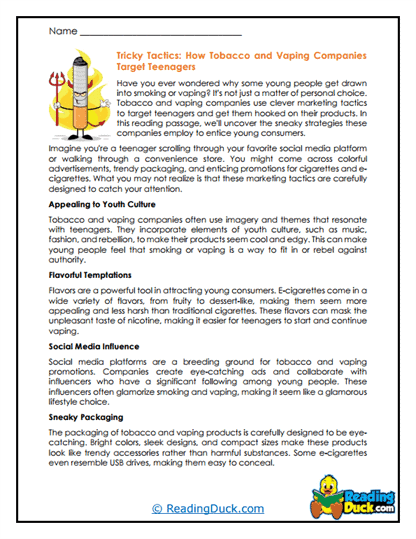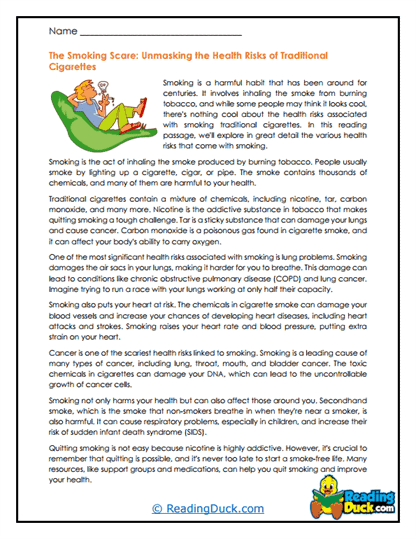Tobacco Worksheets
About Our Tobacco Worksheets
Our Tobacco Worksheets are designed to educate students on the dangers and consequences of tobacco use, providing them with the knowledge and tools needed to make informed, healthy decisions. Tobacco use remains one of the leading causes of preventable illness and death worldwide, making it a critical topic for health education. These worksheets delve into the various aspects of tobacco use, from its addictive properties to its long-term health impacts. All worksheets in the Health category cover a wide range of health-related topics, organized into categories such as Alcohol, Eating Disorders, Exercise, Healthy Relationships, Mental Health, Nutrition, Peer Pressure, Personal Hygiene, Substance Abuse, and Tobacco. These worksheets are not just about reading—they are about understanding critical issues that directly impact students' lives and helping them make informed choices.
This topic contains several worksheet sets, each focusing on a different aspect of tobacco use. Each worksheet set includes:
- Multiple Choice Questions: These questions test students' comprehension of the reading passages, focusing on the health effects of tobacco, the reasons why people start using tobacco, and strategies for quitting.
- Short Answer Questions: Students are asked to provide concise responses that summarize the key information they have learned, such as the chemical components of tobacco, the impact of secondhand smoke, and the social and economic consequences of tobacco use.
- Open-Ended Questions: These questions encourage students to think critically and express their personal thoughts and opinions on tobacco use, fostering deeper connections to the material and promoting thoughtful reflection on the choices they make.
These worksheets help students demonstrate their understanding of the material while encouraging them to apply these concepts to their daily lives. An answer key is provided for each question sheet, making it easy for teachers and parents to assess student progress. All of the worksheets are available as PDF files, which can be easily viewed electronically, downloaded, and printed out.
Understanding Tobacco Use: Health Risks and Prevention
Tobacco use is a significant public health issue, with far-reaching consequences for individuals and society. Educating students about the dangers of tobacco is essential, especially as they are at an age where they may be exposed to peer pressure and marketing tactics that glamorize tobacco use. These worksheets provide a comprehensive overview of tobacco, covering its history, the addictive nature of nicotine, the health risks associated with tobacco use, and strategies for prevention and cessation.
When teaching students about tobacco, it’s important to cover a variety of key concepts and areas of interest:
- The History of Tobacco: Students explore the history of tobacco use, from its origins as a plant used by indigenous peoples to its global spread through colonization and commercialization. They learn about the development of the tobacco industry, the role of advertising in promoting tobacco use, and the growing awareness of its health risks over time. Understanding the history of tobacco helps students see how societal attitudes toward tobacco have changed and why it is important to continue efforts to reduce its use.
- The Addictive Nature of Nicotine: Nicotine, a chemical found in tobacco, is highly addictive. Students learn about how nicotine affects the brain, creating a dependence that makes it difficult for users to quit. They explore the physical and psychological symptoms of nicotine addiction and the challenges of overcoming it. Understanding nicotine addiction helps students appreciate the importance of avoiding tobacco use in the first place and the difficulties faced by those trying to quit.
- The Health Risks of Tobacco Use: Tobacco use is linked to a wide range of health problems, including lung cancer, heart disease, stroke, respiratory illnesses, and other chronic conditions. Students learn about the specific health risks associated with smoking, chewing tobacco, and exposure to secondhand smoke. They explore how tobacco affects different parts of the body, from the lungs and heart to the mouth and skin. Understanding the health risks of tobacco helps students make informed decisions about their health and avoid behaviors that could have long-term consequences.
- Secondhand Smoke and Its Effects: Secondhand smoke, or the smoke exhaled by a smoker or released from the burning end of a cigarette, can be just as harmful as smoking itself. Students learn about the dangers of secondhand smoke, particularly for vulnerable populations such as children, pregnant women, and individuals with respiratory conditions. They explore the social and legal measures in place to protect people from secondhand smoke, such as smoking bans in public places. Understanding the risks of secondhand smoke helps students advocate for smoke-free environments and protect their own health.
- The Social and Economic Consequences of Tobacco Use: Tobacco use has significant social and economic impacts. Students explore how tobacco use can lead to social isolation, financial strain, and lost productivity due to illness. They also learn about the costs associated with treating tobacco-related diseases and the burden it places on healthcare systems. Understanding the broader consequences of tobacco use helps students see how their choices affect not only their health but also their relationships and their communities.
- Marketing and Peer Pressure: The tobacco industry has a long history of using marketing tactics to target young people and make tobacco use appear glamorous or rebellious. Students learn about the ways in which tobacco companies advertise their products, from sponsorships and endorsements to packaging and media campaigns. They also explore the role of peer pressure in encouraging tobacco use and discuss strategies for resisting it. Understanding the influence of marketing and peer pressure helps students recognize and reject these tactics, making healthier choices for themselves.
- Prevention and Cessation Strategies: Prevention is the most effective way to combat tobacco use. Students learn about various strategies for preventing tobacco use, including education, building strong support networks, and promoting healthy alternatives to smoking. They also explore the resources available for those who want to quit, such as counseling, nicotine replacement therapies, and support groups. Understanding prevention and cessation strategies empowers students to take control of their health and support others in their efforts to quit tobacco.
- The Role of Government and Public Health Initiatives: Governments and public health organizations play a crucial role in reducing tobacco use through policies, regulations, and awareness campaigns. Students learn about the measures taken to limit tobacco sales and advertising, increase taxes on tobacco products, and create smoke-free environments. They also explore the impact of public health campaigns on reducing tobacco use and changing social norms around smoking. Understanding the role of government and public health initiatives helps students see the collective effort required to combat tobacco use and how they can contribute to these efforts.
Through these topics, students gain a comprehensive understanding of tobacco use, its risks, and how to prevent it. They learn to appreciate the importance of making informed choices and develop the skills needed to resist peer pressure and advocate for healthy behaviors in their communities.
The Significance of Raising Awareness
Raising awareness about the dangers of tobacco is essential, especially as students are at a critical age for developing habits that can last a lifetime. Tobacco use is the leading cause of preventable death worldwide, and educating students about its risks can help reduce its prevalence. By teaching students about tobacco early on, we provide them with the tools they need to make informed decisions and avoid behaviors that could harm their health and well-being.
Proficiency in this topic benefits students in several ways. Academically, it helps them stay focused on their studies by avoiding the distractions and health problems associated with tobacco use. Personally, it fosters a sense of responsibility for their health and encourages them to make choices that align with their values and goals. Moreover, it equips students with the knowledge and skills needed to support friends and family members who may be struggling with tobacco addiction, creating a more supportive and informed community.
How To Use These Worksheets
These Tobacco worksheets can be effectively integrated into various subjects and classes, particularly in health education, science, and social studies courses. For middle school students, these worksheets introduce the basics of tobacco use and its risks, helping them understand why it’s important to avoid tobacco products. For high school students, the worksheets can be used to explore more complex topics such as the social and economic impacts of tobacco, the science behind nicotine addiction, and the role of government in regulating tobacco. Teachers can also incorporate these worksheets into broader discussions on health and wellness, providing a holistic approach to education that emphasizes the importance of making informed and healthy choices.
Incorporating these worksheets into the curriculum not only reinforces key health principles but also helps students develop essential life skills such as critical thinking, decision-making, and self-advocacy. By engaging with real-world scenarios and questions that require them to apply their knowledge, students build a strong foundation in understanding and preventing tobacco use that will serve them well throughout their lives.
Overall, the Tobacco Worksheets provide a comprehensive and engaging way for students to explore the dangers of tobacco use, gain a deeper understanding of its impact on their health and well-being, and develop the skills they need to make informed and healthy choices.









